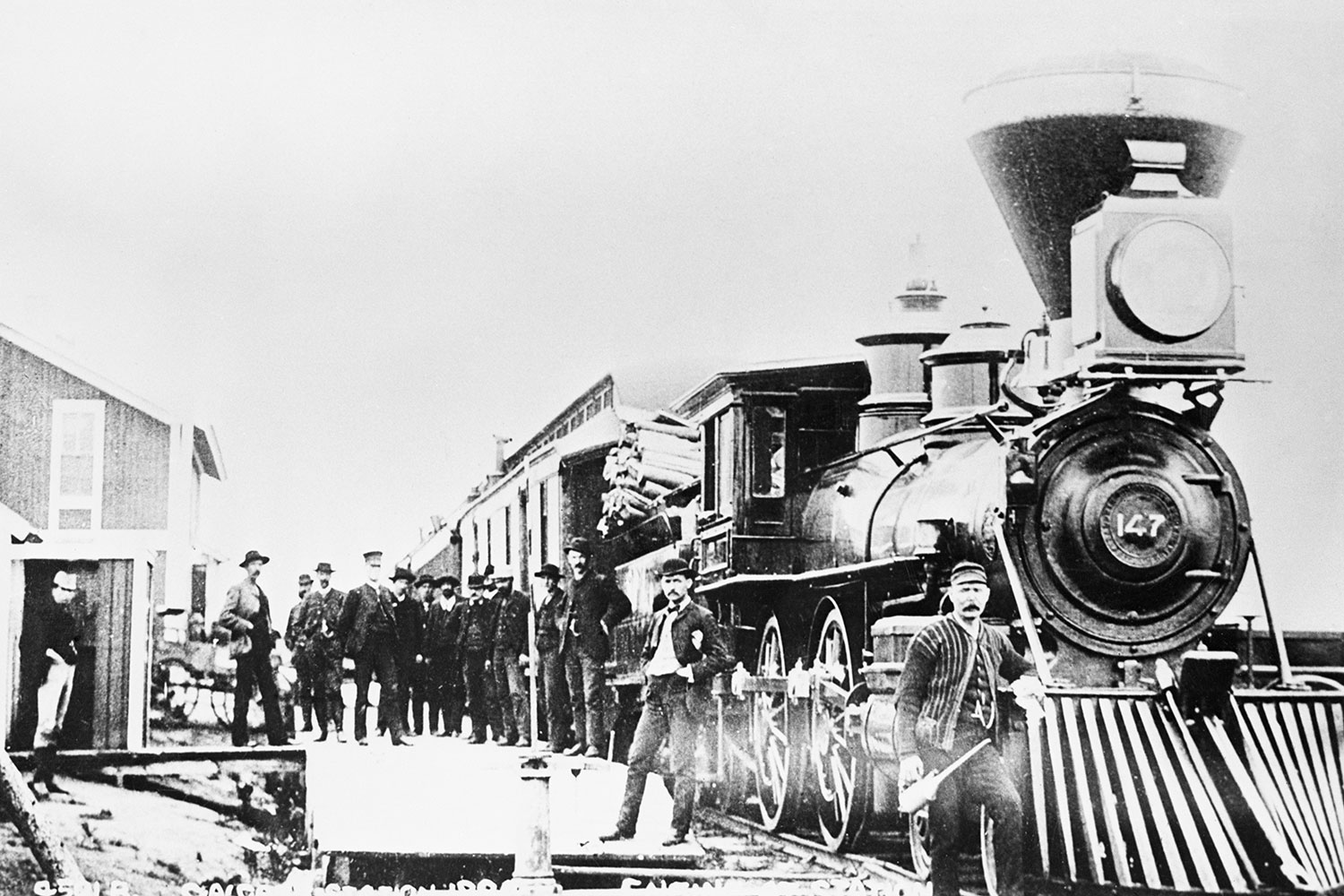
1884 Canadian Pacific Railway passenger train with locomotive 147, Calgary, Alberta.
Glenbow Museum Archive, NA-967-12
March 21, 2018 | Gerald Vander Pyl
Along the rails
A short history of Calgary and the Canadian Pacific RailwayWhen construction of the Canadian Pacific Railway (CPR) reached Calgary in 1883, the company built a train station on its land west of the Elbow River in present-day downtown.
The only problem was that most Calgarians in the small community already lived on the east side of the river, now Inglewood.
Local historian Doug Coats says, try as it might, the CPR could not convince Calgarians to move onto its land, so a plan was devised.
Railway officials asked postmaster James Bannerman to move the community post office nearer to the station and, the story goes, included a promise of $100 and two lots in the new townsite.
"So, one night, the CPR's chief engineer Herbert Holt put a rope around the post office and dragged it across the frozen Elbow River," said Coats. "Calgarians woke up the next morning wondering where their post office was.
"All of a sudden, the stampede was on. Most Calgarians moved over the river and this whole new town started springing up, all strung out along the railway tracks. The whole shape of the town was determined by the railway."
In the coming years, the CPR and other railways had a tremendous impact on how Calgary developed.
Coats says Archibald McVittie, a dominion land surveyor hired by the CPR, laid out the grid system of avenues going east and west and streets going north and south that characterizes the downtown core to this day.
"The whole shape of the town was determined by the railway." - Doug Coats, local historian
"He was the guy who basically planned what the townsite of Calgary was going to look like," he said.
The CPR would later subdivide land it owned into the communities of Scarboro and Mount Royal. These were Calgary's first neighbourhoods to not use a grid system, opting for a winding system of roads instead.
Coats says Scarboro also had all its street names start with the same letter – a first for Calgary – while in Mount Royal, a problem emerged after some rich Americans building the first homes there started calling it American Hill.
"That didn't sit very well with the CPR land commissioner and his friend R.B. Bennett, a young lawyer in Calgary before he became prime minister," said Coats.
The land commissioner began designating Mount Royal streets with names like Allege, Valois, Frontenac and Montcalm, then quipped, "Let's see the Yanks try and pronounce those names."
From about 1907 until the outbreak of the First World War, a population boom occurred in Western Canada after the federal government offered free land to homesteaders.
Coats says settlers arriving by train needed to buy supplies, so Calgary became a distribution centre along the railway.
"That's how we got the warehouse district all along 10th Avenue and 11th Avenue," he said. "They built all these big brick and sandstone warehouses, some of which are still there."
Coats says by 1911, the Canadian Northern and Grand Trunk Pacific railways to the north had built branch lines down to Calgary, which, when combined with earlier railways north to Edmonton and south to Fort Macleod, made the city a railway hub.
Canadian Northern even started looking for land to build a hotel to rival the CPR's Palliser Hotel, and it had its eye on land close to Calgary's burgeoning Chinese community.
Residents there grew worried about skyrocketing rents if the hotel was built, so several of them bought land along the Bow River, which eventually became today's Chinatown.
Railways also brought dignitaries to early Calgary for visits, including Sir John A. Macdonald and his wife Agnes.
According to Coats, to welcome Lady Macdonald, a CPR official sent a telegraph ordering a large bouquet of flowers for delivery to the couple's private rail car. However, due to the abbreviations used and the questionable spelling skills of the telegraph operator, the train instead received a large bag of flour, which greatly confused railway staff.
"So they sent it back," said Coats. "And Lady Macdonald never got the flowers, or the flour."
Coats says while regular rail passenger service to Calgary would eventually end, the remaining railways in Calgary continue to stay busy hauling freight.
"We still have a huge, huge railway industry here in Calgary, but most of us don't realize that because it is in locations that we don't see," he said.
"About the only time you know is when you're sitting at a level crossing and a train comes along. And then everybody goes, 'Oh good, a train!' "
Tagged: Canadian Pacific Railway | CPR | Feature | history | history | Mount Royal | R.B. Bennett | railroad | railway | Scarboro




